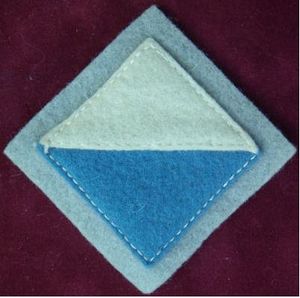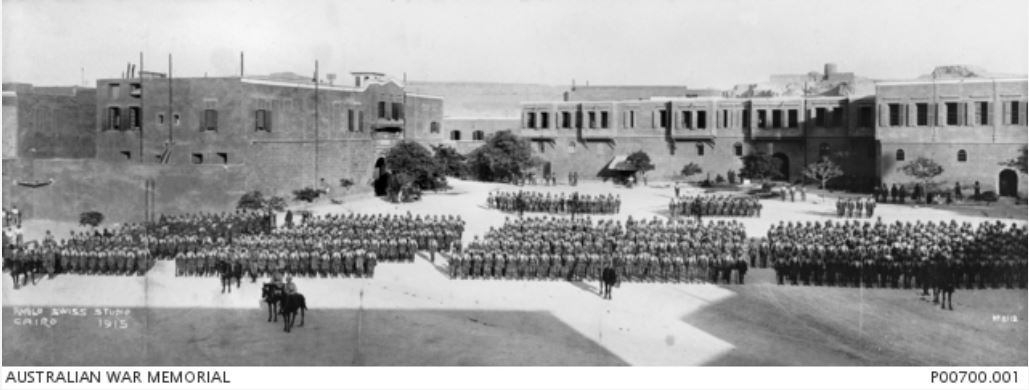28th Battalion
From Our Contribution
 Shoulder patch | |
 28th's arrival parade in Cairo 1915. AWM photo P00700.001 | |
Contents
Brief History
The 28th Battalion came into existence on 16 April 1915 when it was raised at Blackboy Hill Camp, in Western Australia. the 28th Battalion's first batch of volunteers came from personnel who had originally been allocated to the 24th Battalion (subsequently the 24th became a Victorian raised battalion). It was allocated to the 7th Brigade, which besides the 28th and several support units, also consisted of the 25th, 26th and 27th Battalions.
The 28th arrived in Egypt in July and concentrated along with the rest of the 7th Brigade at Abbassia, near Cairo, where they were assigned to the newly formed Australian 2nd Division. In September 1915 elements of the division were dispatched to Gallipoli to provide reinforcements for the Australian and New Zealand forces that had been fighting around Anzac Cove since April.
After spending Christmas on Lemnos, the 28th returned to Egypt in early January 1916. Further training followed before the 7th Brigade was deployed in defence of the Suez Canal. In mid-March 1916, the 28th was transferred to France, as part of the first body of Australian troops to deploy to the European battlefield.
The 28th's first major action came during the Battle of Poziéres in late July and early August when they took part in two attacks. During the first attack, the 28th suffered heavily when they were committed to a night-time attack on the heights that got held up in heavy wire entanglements that the preparatory bombardment had failed to destroy; the battalion's losses were the heaviest in the 7th Brigade, amounting to 10 officers and 360 other ranks. A follow up attack was undertaken on 4 August, which proved more successful, eventually securing the objective. The following day, the Australians were subjected to heavy shelling before they were withdrawn on 6 August.
During 1917 the 28th Battalion was mainly used in supporting roles in a series of battles that followed the German strategic retreat to the Hindenburg Line. Actions were fought at Bullecourt, Menin Road, Broodseinde and Poelcappelle, before the battalion wintered in Belgium.
in 1918 it was transferred to the Somme again in response to the German Spring Offensive. In late March and early April, they held the line around Villers-Bretonneux as the Allies fought to defend the vital railhead of Amiens, before providing support to the 6th Brigade's attack on Ville-sur-Ancre in May.
In June and July as the Allies attempted to regain the initiative, the 28th was involved in a minor action around Morlancourt. On 8 August, the Allies launched their Hundred Days Offensive during which the 28th Battalion was initially engaged around Villers-Bretonneux.
In late August, the Australian 2nd Division advanced to the Somme River, and on 29 August, as the 7th Brigade attacked around Biaches, the 28th was assigned the task of capturing the Amiens–Peronne railway bridge. The following day, they forced their way across the river around Peronne, and during the subsequent Battle of Mont St Quentin–Peronne, they joined the 7th Brigade's advance towards Aizecourt-le-Haut. They continued fighting until early October 1918 when they were withdrawn from the line following an attack on the Beaureviour Line, near the village of Estrees. Throughout the war, casualties amongst the 28th totaled 787 killed and 2,241 wounded.
Battalion Personnel
David Forbes Abernethy Rolf Montgomery Allom Edward Armstrong Reuben Arnold MM William Barge Charles Barnett Albert William Barratt Gordon Edgar (George) Bennett Joseph George Benton Snr Frederick James Bishop Percy James Blake Robert Henry Blake William Bowman Arthur Percy Thomas Boyle Patrick Francis Brennan Edward Briggs David Edward Bromley Henry William Buckland Sylvanus Benjamin Buckland James Willie Bush Leonard Butcher Allahbux Jan Butt Frederick Ernest Capstick Frederick John Chester Ernest Henry Chisholm Oswald Chorlton Joseph Clough Herbert Dunbar Cousens Reuben Leeuwin Cousens Angus Dearden Oliver John Dowell Alexander Dowle Leslie Norman Elkington Harold Empsall Joseph Charles Joshua Farnell Charles Glyn Firns Lionel William Gibbs Stephen Gittins Herbert Goodman Charles Gorringe William Edward Clarence Green Arthur William Griffin William Hall Thomas Percival (Percy) Hanretty Alfred James Hansen MM Walter Hayward Roby Helliwell Paul Henzell Hemy Frederick Hobbs John Hobbs George Henry Holroyd Stephen Henry Horrocks William John Howe Gordon Weston Johanson Joseph Reginald Jones Leo Patrick Kane Henry Richard Keefe Basil Kelley Walter David Francis Kerridge Osborne King William Alfred Leaver Arthur Lewis Ernest Alfred (Jack) Lewis John Richard Lewis Reginald Peter Lewis William Wilfred Gerald Liddington Frederick Thornton Lindley William Mathews William Edward McKenna Patrick Michael
- Albert Thomas Myers 3 Jul 1917 - 22 Jan 1918
Reuben Douglas Naughton Robert George Orrock Harry Pickard William Augustus Povah Bertram Ernest Powell Frederick James Powell Charles William Price Henry George Price Robert Landen Rayner Thomas Henry Rice Douglas Gordon Scott MC Albert Edward See Reginald Grove Sexty MID Thomas Joseph Sheehan Roland Parker Shelley Ephraim Shepherd Luke Siford Keith Herbert Sloan Ernest Charles Thomas Samuel Simpson Thompson William Thomson Arnold Thorp Henry Albert Thorp Hubert Harris Thorp Sidney Francis Till George Charles Unwin Arthur John Verrall Albert Edward John Walls Joseph Watson Stuart Alan Webb Ernest Wells Claude Algernon Wright
Battle Honours
- Gallipoli 1915
- Egypt 1915–16
- Somme 1916–18
- Poziéres
- Bullecourt
- Ypres 1917
- Menin Road
- Polygon Wood
- Broodseinde
- Poelcappelle
- Passchendaele
- Amiens
- Albert 1918
- Mont St. Quentin
- Hindenburg Line
- Beaurevoir
- France and Flanders 1916–18.
Individual Honours
- 1 Companion of the Order of St Michael and St George (CMG)
- 5 Distinguished Service Orders (DSOs)
- 20 Military Crosses (MCs) and two bars (Douglas Gordon Scott MC)
- 14 Distinguished Conduct Medals (DCMs)
- 69 Military Medals (MMs) and two bars (Alfred James Hansen MM)
- 5 Meritorious Service Medals (MSMs)
- 21 Mentions in Despatches (MIDs) and (Reginald Grove Sexty MID)
- 6 foreign awards
Notes
Content for the history and honours sections has come from a combination of Wikipedia and the Australian War Memorial websites.